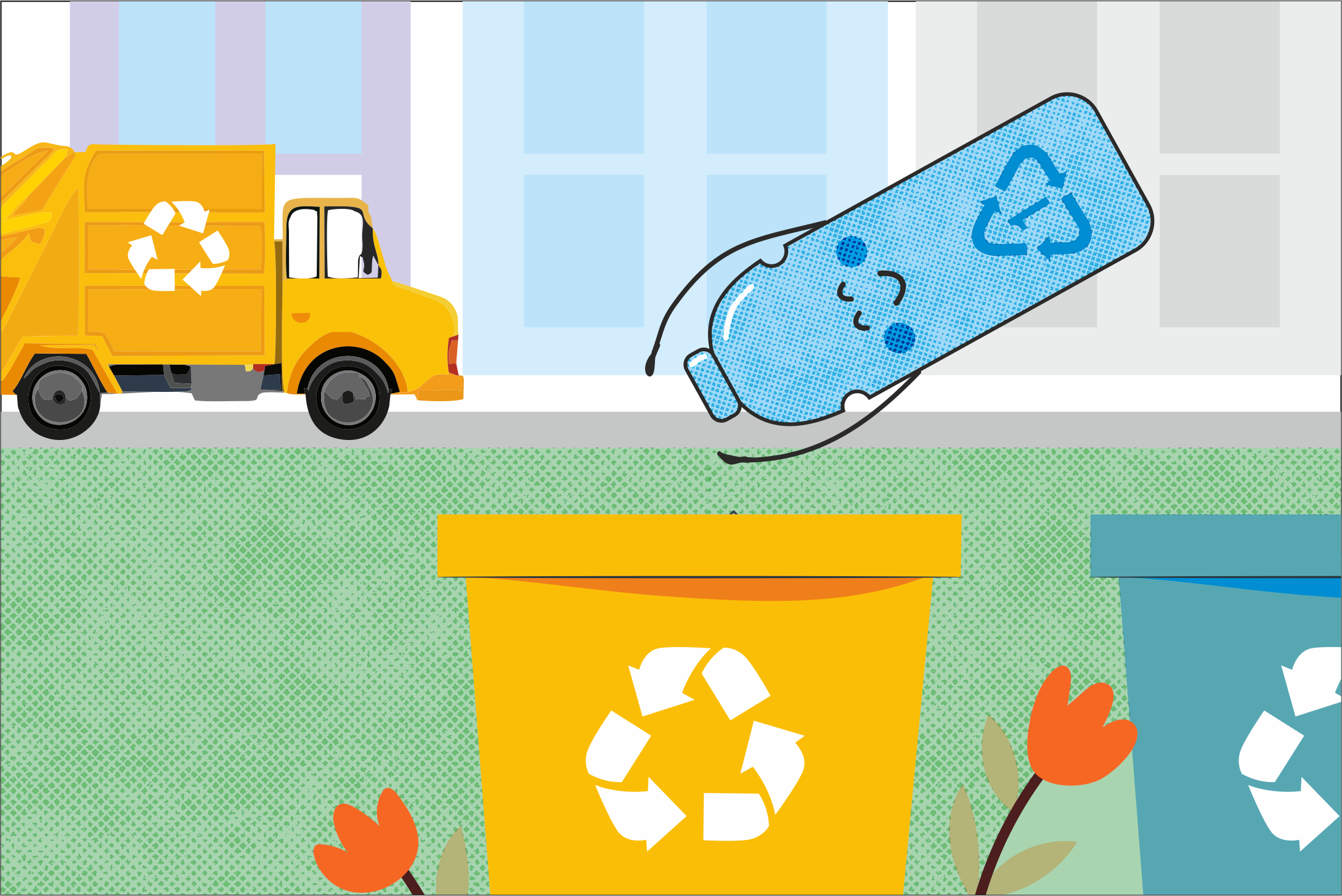Why Belarus needs circular economy?
The Story of One Plastic Bottle
October 24, 2022

280 thousand tons of plastic waste, more than half of which being packaging, end up in landfill in Belarus every year.
In Belarus, 280 thousand tons of plastic waste, more than half of which being packaging, end up in landfill every year. Belarusians annually dispose of about 15 kilograms of plastic bottles, cans, containers, and bags per capita. Most of these can be recycled, however, only one-third (approximately 97,000 tons per year), is collected and sent for further processing. We can give used plastics a new life. This is a story of an ordinary plastic bottle showing how we can do this.

Meet the main character of our story - the Bottle - one of 580 billion plastic bottles produced globally.
The bottle is one of 580 billion plastic bottles produced globally. It was blow moulded in Belarus to be filled with a local mineral water. It had a numeric character ‘1’ imprinted on it meaning that this bottle is made of polyethylene terephthalate, also known as PET plastic. The Bottle is not unique: packaging for beverages, juices, vegetable oils most common are made from the recyclable PET plastic.

Types of plastic and their characteristics
Whether a bottle will be recycled or not depends on our action. We can put into a special container for plastic or into an ordinary garbage container mixed with other waste. Knowledge of special labelling will guide on how to dispose used plastic. Other key reason for a bottle to find its way to one or another container is the season and place when a bottle is thrown away.
Our bottle became a part of an experiment of the joint United Nations Development Program (UNDP) and the Ministry of Natural Resources and Environmental Protection of the Republic of Belarus project. A special GPS-tracker attached to the bottle helped to trace it from the moment the Bottle was dumped into a separate waste collection container.

Whether a bottle will be recycled or not depends on our action.
On the second day of the journey the Bottle arrived at a recycling plant where it was separated from other types of waste and sent to a shredder and further down the line to be refined from impurities. Finally, the Bottle came out of the line as special plastic pellets - a raw material for production of pipes, hoses, boxes and other products. 13 other bottles undertook similar journey in Minsk, Homiel, Lida and Masty. The experiment showed that the existing system of waste collection and transportation in Belarus works well and supplies processing plants with recycled materials.

The story of the Bottle showed one possible solution for sustainable plastic waste management.
Some people see how waste collectors throw both garbage and recycling into the same compartment of a truck and become very dissapointed thinking that all waste will end up in one landfill anyway. For optimisation of efforts waste separation is highly advisable because it is much easier to recycle.
The experiment also demonstrated that plastic goes both into containers for separate collection, where it makes up 16-28% of all waste, and into mixed waste containers, where it can amount to 4-19%. Residents of large cities use more plastic, however, they also sort plastic waste better than people in small towns and rural areas. In summertime urban communities dispose 1.27-1.73 times more plastic than in winter. At the same time residents in Minsk, regional centers, and big cities better sort plastic in summer, while small towns do this better in winter.
The story of the Bottle showed one possible solution for sustainable plastic waste management. If disposed to a separate waste container, plastic will unlikely ends up in landfills and will not be a source of greenhouse gas emissions. It will have a high chance of recycling to became new product. Such approach contributes to circular economy - a model of sustainable production and consumption that contributes to both economic growth and environmental protection.

Plastic is recycled to became a resource for new products.
Belarus made commitments to meet the goals of the Paris Agreement on combating climate change. Improvement of environmentally sound waste management and recycling is a part of the country’s strategy to reduce greenhouse gas (GHG) emissions, pollution and promote circular economy.
To support Belarus' on this path, the UNDP Belarus’ Accelerator Lab joined efforts with the Ministry of Natural Resources and Environmental Protection of the Republic of Belarus to develop the National Circular Economy Strategy until 2035. The document will spotlight on the important role of plastic recycling for GHG emissions reduction, money and energy saving. According to the Recycling Centre at Stanford University, USA, one ton of recycled plastic saves 16.3 barrels of oil or 5,774 kilowatt hours of electricity.
The journey of the Bottle showcases the efficiency of the system for waste collection, transportation, and extraction of recyclable materials in Belarus. However, much depends on people and their behaviour. Environmental awareness and green knowledge about separate waste management are one of the pillars of the circular economy.
It is expected that by 2025, a circular economy will be annually contributing more than trillion US dollars to the global economy revenue growth. In the long run, this will benefit enterprises, especially small businesses by offering new economic opportunities.
The implementation of holistic solutions for plastic treatment takes time. At the national level, systemic and complex actions are taken gradually to reduce the use of polymer packaging and replace it with environmentally friendly alternatives. People in Belarus can change their waste collection habits to help reduce GHG emissions, pollution and bring Belarus closer to the achievement of the Sustainable Development Goals (SDGs).

 Locations
Locations

